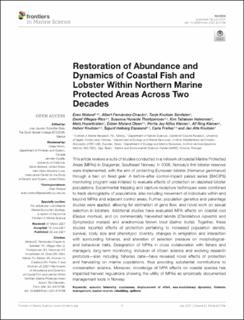| dc.contributor.author | Moland, Even | |
| dc.contributor.author | Fernández-Chacón, Albert | |
| dc.contributor.author | Sørdalen, Tonje Knutsen | |
| dc.contributor.author | Villegas-Rios, David | |
| dc.contributor.author | Thorbjørnsen, Susanna Huneide | |
| dc.contributor.author | Halvorsen, Kim Aleksander Tallaksen | |
| dc.contributor.author | Huserbråten, Mats Brockstedt Olsen | |
| dc.contributor.author | Olsen, Esben Moland | |
| dc.contributor.author | Kleiven, Portia Joy Nillos | |
| dc.contributor.author | Kleiven, Alf Ring | |
| dc.contributor.author | Knutsen, Halvor | |
| dc.contributor.author | Espeland, Sigurd Heiberg | |
| dc.contributor.author | Freitas, Carla | |
| dc.contributor.author | Knutsen, Jan Atle | |
| dc.date.accessioned | 2022-03-02T12:04:11Z | |
| dc.date.available | 2022-03-02T12:04:11Z | |
| dc.date.created | 2022-02-11T15:23:40Z | |
| dc.date.issued | 2021 | |
| dc.identifier.citation | Frontiers in Marine Science. 2021, . | en_US |
| dc.identifier.issn | 2296-7745 | |
| dc.identifier.uri | https://hdl.handle.net/11250/2982466 | |
| dc.description.abstract | This article reviews a suite of studies conducted in a network of coastal Marine Protected Areas (MPAs) in Skagerrak, Southeast Norway. In 2006, Norway’s first lobster reserves were implemented, with the aim of protecting European lobster (Homarus gammarus) through a ban on fixed gear. A before–after control-impact paired series (BACIPS) monitoring program was initiated to evaluate effects of protection on depleted lobster populations. Experimental trapping and capture-recapture techniques were combined to track demography of populations, also including movement of individuals within and beyond MPAs and adjacent control areas. Further, population genetics and parentage studies were applied, allowing for estimation of gene flow, and novel work on sexual selection in lobsters. Additional studies have evaluated MPA effects on coastal cod (Gadus morhua), and on commercially harvested labrids (Ctenolabrus rupestris and Symphodus melops) and anadromous brown trout (Salmo trutta). Together, these studies reported effects of protection pertaining to increased population density, survival, body size and phenotypic diversity, changes in emigration and interaction with surrounding fisheries, and alteration of selection pressure on morphological- and behavioral traits. Designation of MPAs in close collaboration with fishers and managers, long-term monitoring, inclusion of citizen science and evolving research protocols—also including fisheries data—have revealed novel effects of protection and harvesting on marine populations, thus providing substantial contributions to conservation science. Moreover, knowledge of MPA effects on coastal species has impacted harvest regulations showing the utility of MPAs as empirically documented management tools in Norway. | en_US |
| dc.language.iso | eng | en_US |
| dc.title | Restoration of Abundance and Dynamics of Coastal Fish and Lobster Within Northern Marine Protected Areas Across Two Decades | en_US |
| dc.type | Peer reviewed | en_US |
| dc.type | Journal article | en_US |
| dc.description.version | publishedVersion | en_US |
| dc.source.pagenumber | 12 | en_US |
| dc.source.journal | Frontiers in Marine Science | en_US |
| dc.identifier.doi | 10.3389/fmars.2021.674756 | |
| dc.identifier.cristin | 2000627 | |
| dc.relation.project | EC/H2020/793627 | en_US |
| dc.relation.project | Norges forskningsråd: 294926 | en_US |
| cristin.ispublished | true | |
| cristin.fulltext | original | |
| cristin.qualitycode | 1 | |
